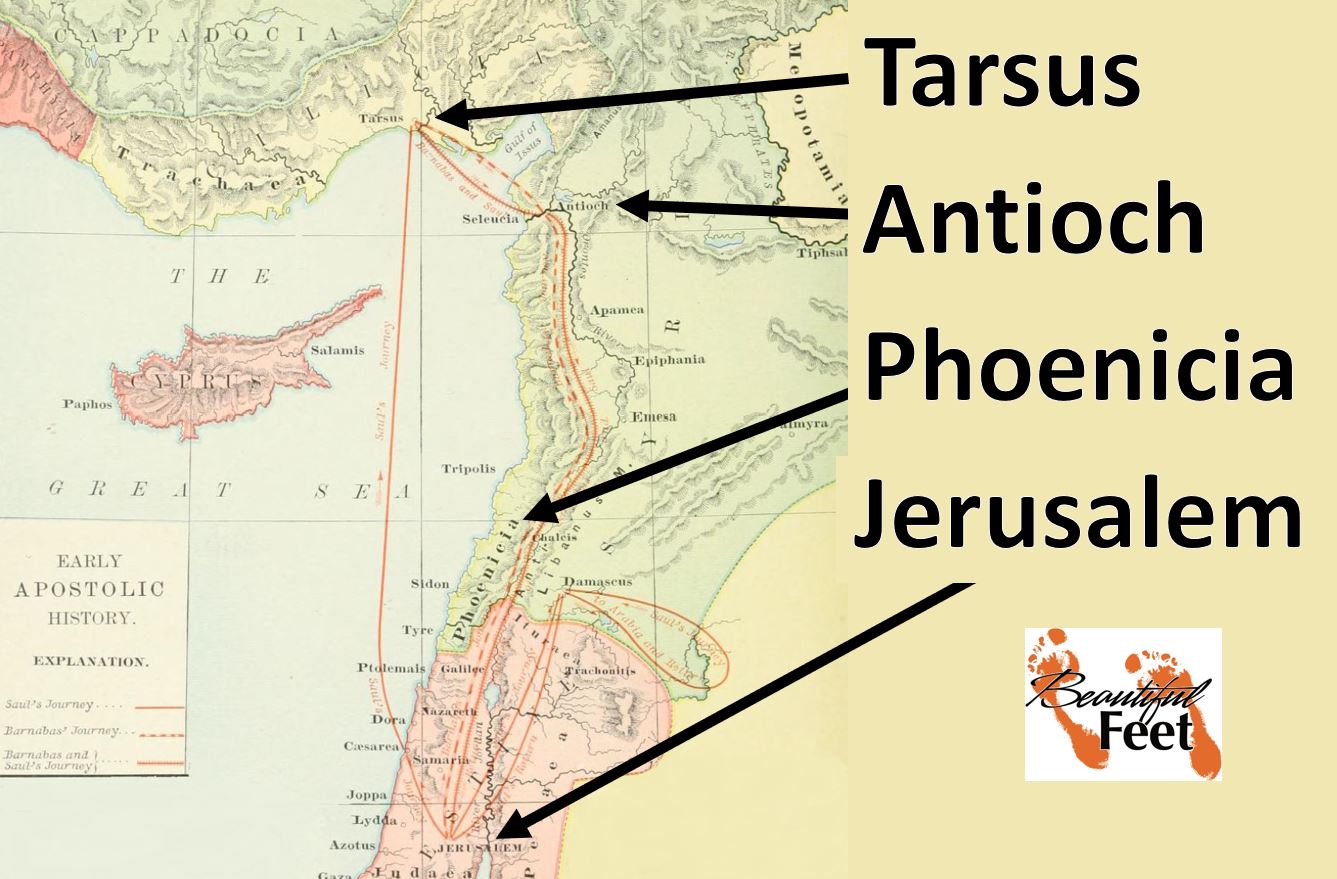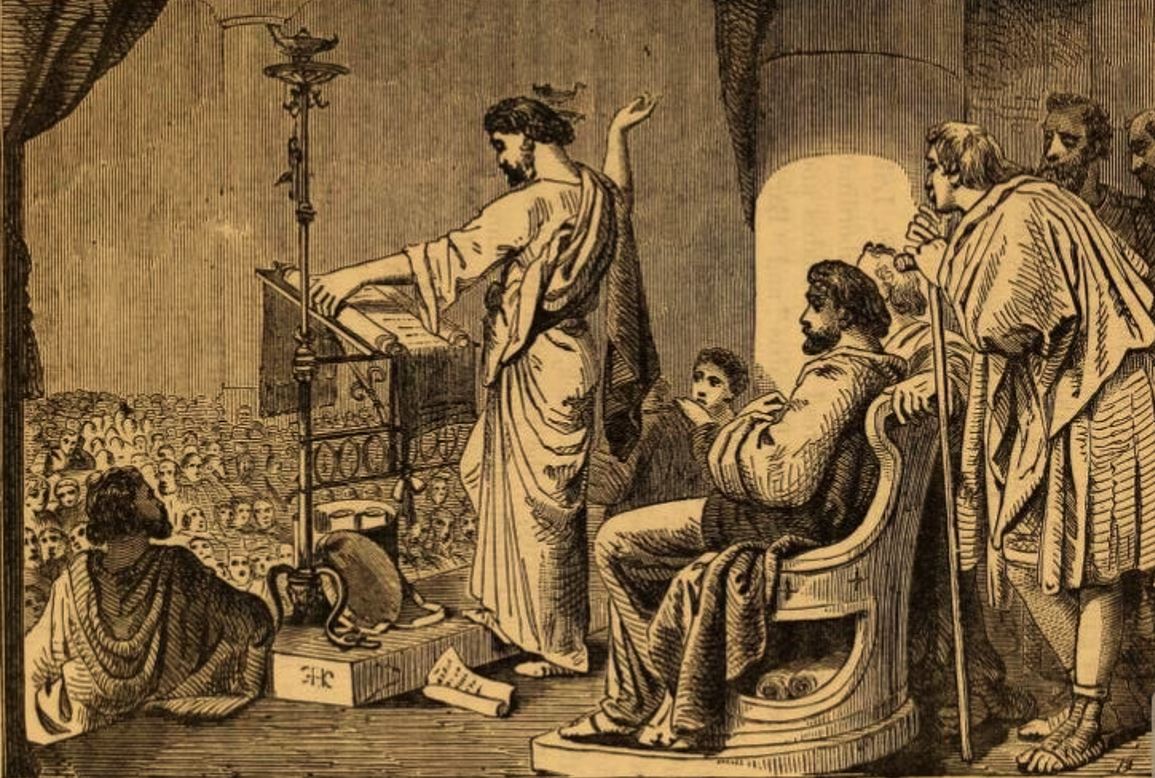

This revival account is found in Acts 11:19-30; Acts 12:24-25 and Acts 13:1-3.
Introduction
By 42 A.D., the evangelization of the world was in full swing (Acts 1:8). There were already many thousands of Jewish followers of Jesus, and the number of Gentile followers was increasing daily.
There is the record of many Gentile converts in Samaria (Acts 8:12-15), as well as a Gentile convert on the desert road leading to Gaza (Acts 8:26-39), as well as a revival involving Gentiles in Caesarea (Acts 10:44-48). With these few recorded instances, we feel safe to say that there were also other locations throughout the Roman world where both Jews and Gentiles were receiving the Gospel and placing their faith in Jesus as “the Savior of the world” (John 4:42).
Accounts of Gentiles Receiving the Gospel
► 27 A.D. Revival in the Samaritan Village of Sychar
► 31 A.D. Revival in Samaria
► 37 A.D. Revival in Caesarea
Antioch—Launching Pad for Missions
After Rome and Alexandria, Antioch was the largest city in the Roman Empire, having an estimated population of 500,000. This city became the base for the apostle Paul during his missionary journeys.

Locations mentioned in this revival account
Sequence of Events as the Revival Unfolded
► The persecution of the Jerusalem church, as recorded in Acts 8:1-3, occurred in 31 A.D., resulting in the scattering of the believers. Even though the church was under tremendous persecution, it didn’t stop those who were scattered from preaching the Gospel in the areas they fled to.
► The believers at this time were primarily sharing the Gospel with Jews only, Jews having already been dispersed throughout the then-known world many generations prior to this point in time (Acts 2:5-11; 11:19).
► Note the difference in the two verses of Acts 11:19-20. In Acts 11:19, “They preached the word of God, but only to Jews.” Then in Acts 11:20 we see that they “began preaching to the Gentiles.”
► Initially it was only the Jews in Antioch that were receiving the Gospel message. Then arriving in Antioch were believers coming from the island of Cyprus and from the northern African city of Cyrene (Acts 11:20—Shahat, Lybia today). It was these who began preaching the Gospel to the Greek-speaking Gentiles.
► From this sharing of the Gospel, and with “the power of the Lord” being with them, “a large number of these Gentiles believed and turned to the Lord” (Acts 11:21).

West coastline of the Mediterranean Sea, showing Barnabas and Saul’s journeys in this account (right click on image to see an expanded view)
Barnabas was originally from the island of Cyprus and evidently received his training in Jerusalem. He was still there, involved in ministry with the leaders of the Jerusalem church, when reports of the Antioch revival arrived (Acts 4:36).
Barnabas was then sent by the leaders of the Jerusalem church to investigate the reports they had received about Antioch (Acts 11:22). Upon his arrival in Antioch, and having seen that the report was true, he contributed to the movement (Acts 11:23), resulting in a second wave of revival, and the result was that “many people were brought to the Lord” (Acts 11:24).

Barnabas, Saul, and others, “teaching large crowds of people” (Acts 11:26)
The Necessity of Training New Christians
There were so many new followers of Jesus, both Jews and Gentiles, that it was evidently too much work for Barnabas to solidify them in their faith, so he went “to Tarsus to look for Saul” (Acts 11:25).
After finding Saul, Barnabas brought him back to Antioch, and “Both of them stayed there with the church for a full year, teaching the large crowds of people” (Acts 11:26).
As the believers grew in their faith and began to reflect Jesus in their lives, these Antiochian believers began to take on the nature of Jesus, resulting in the first time the word Christian was used to describe followers of Jesus (Acts 11:26).
The Prophet Agabus and Financial Gifts for the Poor
The Jerusalem church sent additional prophets to Antioch, and one of them, a prophet named Agabus, predicted “that a great famine was coming upon the entire Roman world” (Acts 11:27-28).
In preparation for that famine the believers in Antioch made a collection of finances and gave it to Barnabas and Saul for them to take to the church in Jerusalem for distribution to the poor (Acts 11:29-30).
After having delivered that donation to the Jerusalem church, Barnabas and Saul returned to Antioch, bringing “John Mark with them” (Acts 12:25).
Holy Spirit Directed Missionary Work
The church of Antioch had several prophets and teachers that were instrumental in the spiritual development of the Christians in that region (Acts 13:1):
1. Barnabas (Acts 4:36; 9:27, etc.)
2. Simeon: possibly Simon of Cyrene, the one forced to carry Jesus’ cross (Luke 23:26)
3. Lucius of Cyrene: possibly one of the first to preach the Gospel to the Gentiles in Antioch (Acts 11:20)
4. Manaen
5. Saul: who later became known as the apostle Paul (Acts 13:9)
As these five leaders were conducting a united time of worship, while fasting, the Holy Spirit spoke, evidently through the spiritual gift of prophecy, giving direction for the church’s next missional steps:
Appoint Barnabas and Saul for the special work to which I have called them (Acts 13:2).
After that word of prophecy, they committed to more fasting and prayer, evidently to receive greater clarity on the mission Barnabas and Saul were to conduct, and then “the men laid their hands on them and sent them on their way,” thus launching Paul’s First Missionary Journey—which resulted in the 48 A.D. Revival in Asia Minor (Acts 13:3).
Important Lesson Learned from this Revival Account
There is always a tendency during revivals to get caught up in the excitement of the moment and allow the solid teaching of the Word of God to take a back seat. We notice that Barnabas did not allow emotions to drive the revival. He took the time to travel the 145 miles to Tarsus, find Saul (Paul), and bring him back to Antioch, where together with four other prophets and teachers, they solidified the faith of the large crowds of believers by teaching them the word of God (Acts 11:25-26).
Return to List of Revival Stories
Chet & Phyllis Swearingen:
Office: (260) 920-8248
romans1015@outlook.com
Beautiful Feet
P.O. Box 915
Auburn, IN 46706

